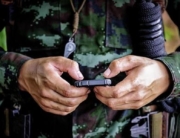by Linda Jackson
Apps on our phones and tablets are meant to make life easier and point us to the services and providers who can meet our needs. There’s no reason why such innovation can’t also simplify and improve the stressful process that military children and their parents face every time they enroll in a new school.
That’s the idea behind a new four-year, $5 million grant from the Department of Defense Education Activity (DoDEA) to the USC School of Social Work, Chula Vista Elementary School District (CVESD) and four other military-connected school districts in San Diego and Riverside counties—Bonsall Union School District, Fallbrook Union High School District, Oceanside Unified School District and Temecula Valley Unified School District. USC and CVESD will jointly administer the grant for the consortium.
Just as Yelp directs us to nearby restaurants and PowerSchool gives parents real-time updates on their children’s grades and homework assignments, new apps developed as part of the grant will streamline the way families complete enrollment forms, find tutoring programs, sign up for extra-curricular or after-school programs, learn about community-based resources and stay in touch with key district contacts who can answer additional questions. These tools will help educators connect new families to the school community.
The new initiative—called Welcoming Practices that Address Transition Needs of Military Students in Public Schools—will ensure that district and school staff members receive the professional development they need to create welcoming and effective transition procedures that give students a successful start at their new school. A modular website that includes local, district and nationwide resources focusing on transitions in and out of schools will be created by the consortium members and serve as a model that could eventually be used by any school in the country. Similarly, an app for both iPads and Android-based tablets will help district and school personnel connect each family to school, community, military and county-level resources based on their needs and their proximity to services.
Apps will also give parents and students reminders of important deadlines, appointments with counselors, orientation events and family gatherings to help ensure students are doing well both academically and socially as the school year progresses. Having specific names and locations of local, district and national resources at one’s fingertips can ease the transition process for students, parents and administrators. Pulling these services together into a digital one-stop shop can greatly improve a family’s experience during the first day, week and month in a new school. Using existing social media tools could also help students connect with students in former and new schools both before and after their move.
“I’m hoping this kind of technology will help thousands of military children and that the lessons learned will help any child in transition between schools,” said Ron Astor, a professor in the School of Social Work and the Rossier School of Education (by courtesy).
Astor will lead the project at USC, and Tamika Gilreath, an assistant professor in the School of Social Work, will be the co-principal investigator. Professor Rami Benbenishty from Bar Ilan University in Israel will be the evaluator of the project.
“Technology that supports the human interaction between all those involved in transitions could change both social and academic experiences of students who go through many schools during their K-12 experiences,” said Benbenishty.
Francisco Escobedo, superintendent of CVESD, will be the lead for the five school districts partnering with USC. The other four superintendents participating are Larry Perondi of Oceanside Unified, Justin Cunningham of Bonsall Union, Dale Mitchell of Fallbrook Union High and Tim Ritter of Temecula Valley Unified.
The new grant has been inspired by what Astor, the research team, district personnel and military school liaison officers have learned both through decades of work and through the Building Capacity in Military-Connected Schools partnership—that transition, whether between schools or when a parent leaves or returns from a deployment, is one of the greatest challenges faced by military families. Transition is also a major issue for non-military families, and lessons learned in the new project may have strong implications for any child transitioning in and out of school.
Data from the California Healthy Kids Survey, which has been analyzed as part of the Building Capacity initiative, shows that a third to two-thirds of students in the five districts have changed schools more than once in a five-year period. And some schools have very large student turnover rates. Many districts and schools also vary tremendously in how they address transition issues for families.
There are numerous examples of how schools can successfully guide families through the transition process. School liaison officers and schools with large numbers of military students can also provide templates for effective school district practices. The variation in the way schools have handled transition has long been a major policy issue for military families and led to the development of the Interstate Compact on Educational Opportunity for Military Children, which has now been adopted by 45 states. Websites and apps can be additional resources for educating both school districts and families on the Compact’s provisions.
The goal of using technology to modernize and simplify aspects of the school transition process is not to eliminate the face-to-face interaction that occurs in the attendance office. Instead, it is to resolve the often-confusing dilemma of not knowing who to talk to, not having the right forms or missing an important deadline. Ideally, having clearly defined resources and contacts at the local, district and national levels—along with related apps—will help parents and students form deeper connections with staff members and other families even before they arrive at the school.
The new partnership will also assist districts in creating and centralizing some transition procedures, relieving schools of having to handle the process themselves and allowing them to focus instead on academic support and helping new students and parents form relationships with school staff members and other families. This systematic approach could also help increase the flow of communication between the school liaison officers and the many schools and families they serve.
“We encourage novel methods of instructional delivery and innovative ways to meet the needs of today’s students and families. Our partnership with USC helps improve communication with our military-connected families through innovative applications of technology,” said Escobedo. “The suite of tablet and smartphone applications funded through the new grant will ensure that transitioning students and parents are informed of all required documentation and relevant eligibility criteria even before they arrive to our district. The project will increase school engagement and better inform families about their student’s school and activities.”
This article also appeared on the USC School of Social Work news site.








